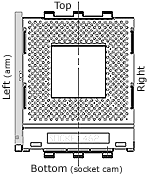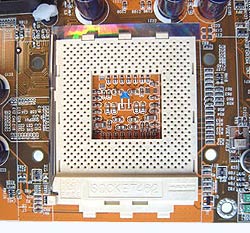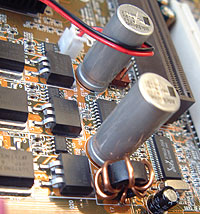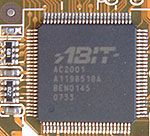The
KR7A-133RAID uses the High Point
HPT-372 chipset which has support for Ultra/133 based (also 66/100) hard drives
and can do RAID's 0, 1 and 0+1. Here's a brief description of IDE
RAID.
IDE RAID 0 is not really considered a true
RAID since there isn't any data redundancy. RAID 0 takes two drives of the same
size/configuration and stripes them, meaning it makes one big drive out of two
equal ones. This improves performance by cutting hard drive latency in half.
Since the data is divided equally and written on two hard drives it also
increases the data bandwidth by two. The reason it's not considered true RAID is
because if one drive fails, all data is lost.
IDE RAID 1 on the other
hand mirrors two drives of the same size, so in theory if one drive fails, the
other will take over as the primary hard drive and the system can continue to
operate normally. This is what is supposed to happen with a SCSI hard drive
setup and it actually works pretty well there.
The IDE subsystem doesn't allow hard
drives to be disconnected while the computer is still powered up and in use like
SCSI can unless you have a special HDD tray. Generally, when one IDE drive fails
the system usually locks up anyway. The data is safe since it's mirrored on the
other drive which is the real benefit.
With IDE RAID 0+1, you need four hard drives of the same
configuration/size. What RAID 0+1 does is stripes two sets of two hard drives,
one set for a RAID 0 configuration and the other for RAID 1. What this does is
offer the best of both worlds, the high performance of RAID 0, with 100% data
redundancy of RAID 1. Hence the name RAID 0+1. The only downside would be the
need for four identical hard drives.
Around the Socket: Heatsink
Clearances
| pcstats heatsink clearance measurements |
| top clearance: |
7 mm |
| bottom (cam)
clearance: |
10 mm |
|
| left side (arm)
clearance: |
20
mm |
| right side clearance |
18 mm |
|
| socket mounting
holes: |
4mm
ødia. |
| max. heatsink base
dimensions: |
~77x94
mm |
|
 Note: Approx.
measurements are made from the edge of the socket (not the clips) to
the closest obstacle taller than the ZIF socket itself. Note: Approx.
measurements are made from the edge of the socket (not the clips) to
the closest obstacle taller than the ZIF socket itself.
The socket is 51mm across, and 62mm from
top to bottom. | |
 |
Abit took the liberty to clear the area next to
the CPU socket so that larger heatsinks such as the Swiftech MCX462 or Alpha's PAL 8045
have a good chance of fitting with room to spare. The only possible hitch we can see is that the top of the
socket is very close to the top of the motherboard, so longer heatsinks
might hit the ceiling of the case or bottom of the power
supply.
Large Size
Capacitors:

Just above the AGP slot are two
rather large Nichicon 4700 microfarad capacitors running on a voltage of 6.3V. Staring
with their KG7 line of boards, Abit has started to use larger capacitors in this
area instead of the smaller ones found out the KT7/KT7A/KT7E to improve
stability reportedly.
 Located next to the Highpoint chipset is a rather unique
Abit branded chipset which isn't mentioned in the users manual. A quick
google search
reveals that the Abit AC2001 chipset has a port
80 debug card built into it and include's Soft Menu III design
circuits. We're not really sure why this chip is on the board since the KR7A-133RAID doesn't have
any onboard diagnostic LED's for the port 80 card like those found on the Epox boards
or even Abit's own TH7II.
Located next to the Highpoint chipset is a rather unique
Abit branded chipset which isn't mentioned in the users manual. A quick
google search
reveals that the Abit AC2001 chipset has a port
80 debug card built into it and include's Soft Menu III design
circuits. We're not really sure why this chip is on the board since the KR7A-133RAID doesn't have
any onboard diagnostic LED's for the port 80 card like those found on the Epox boards
or even Abit's own TH7II.
Also, it is my understanding that
Soft Menu III is built into the BIOS, so why they need custom IC is still a
little bit of a mystery.
As you can
see from the board layout, the KR7A-133RAID doesn't come with any onboard audio. In a
time where onboard audio seems all the rage and every motherboard manufacturer forces
this option on consumers, it was a rather refreshing change to see
that Abit has not included any form of onboard audio - be it VIA's AC'97
codec or C-Media's 8738 hardware sound card. I know many of you really like
onboard sound though.

